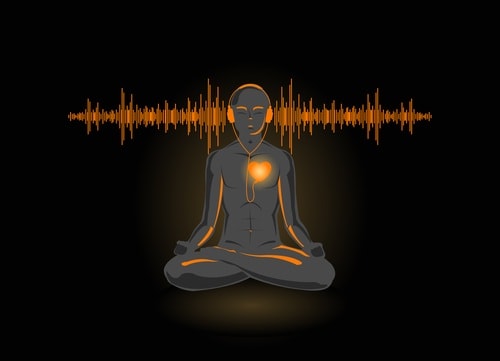
Meditation music for healing is a common practice among many. Music can be used as a form of relaxation or meditation. The meditations use specific sounds that guide you into a state of calmness. These include binaural beats, monaural beats, and white noise. White noise is created by combining many frequencies together at once, which creates a soothing background for your mind to relax. Often these mediations make use of sounds with specific frequencies which shift our brainwaves and translates or transitions us into a state of calm and ease.
Guided meditation can be done with music too and it is a form of sound healing in which you meditate to voiced instruction, either in a session or class, or using a video or app. This type of therapy involves playing instruments such as drums, flutes, guitars, keyboards, etc. for therapeutic purposes. It’s often done while someone listens to music they enjoy.
This also relates to Neurological music therapy which helps treat conditions like autism, Alzheimer’s disease, Parkinson’s disease, traumatic brain injury, stroke, multiple sclerosis, epilepsy, dementia, post-traumatic stress disorder, attention deficit hyperactivity disorder, and other neurological diseases.
Releasing stress through musical frequencies
The human brain is an amazing organ, but it has one major drawback: It’s very sensitive to noise. When we are stressed or anxious our brains become hyper-vigilant for any kind of sound that might be associated with danger. Our brains are drawn to sound.
Scientifically this makes sense, soundwaves directly relate to brainwaves as they both operate on frequencies. Since we are sensitive to auditory senses we can bring ourselves into specific brainwave states by playing specific sound frequencies through music.
1. Alpha Brainwaves – low amplitude (8 -13Hz)
Refers to the state of ease and calm. Decrease in pain and increase in memory.
2. Beta – (12 – 38Hz)
Refers to the state of alertness and being awake. Happens when we are actively concentrating and highly focused on a task. It decreases feelings of anxiety while increasing feelings of control.
3. Delta (lowest frequency – 0.5 – 4Hz)
Refers to the state of deep sleep
4. Theta (4 – 7 Hz)
Refers to the state of deep meditation and relaxation. Reduces anxiety while increasing our mind’s absorbable capacity for knowledge. This is where we build a higher sense of intuition.
5. SMR (12.5 – 15Hz)
Refers to being calm but hyper-aware state. This is where we achieve our ‘states of flow’.
6. Gamma (highest amplitude – 38 – 100 Hz)
Refers to the state of thought formation and processing. A highly active state increases our creativity, task processing, and learning patterns.
The Uses and Benefits of Music Therapy
Music is a universal language that everyone understands, regardless of age or culture. It can be used in many ways to help people with physical disabilities, mental health issues, developmental disorders, learning difficulties, autism spectrum disorder, Alzheimer’s disease, post-traumatic stress disorder, and more.
Different types of music used for meditation:
1. Binaural beats
Binaural beats create brainwaves that match those produced naturally during certain activities such as sleep.
Our normal hearing ranges from 20Hz to 20 000 Hz – by using binaural beats our brains identify a lower frequency which we might not be able to hear and alters our brainwave state as a result. When you listen to two tones at the same time, your brain creates a binaural beat.
Your brain processes the two tones in a different way as one singular beat with a different frequency.
For example, if you are listening to a 330 Hz tone with your left ear and a 333 Hz tone with your right ear, you would be hearing a 3 Hz tone which would relate to a specific brainwave.
Your brain activity matches the frequencies set by the beat when you listen to a binaural beat. The effect is called Frequency- Following. This means that you can use binaural beats to train your mind to reach a certain brainwave and specific mental state.
The power of these certain brainwaves can increase when listening to binaural beats, which controls or changes different brain functions such as the formation of thoughts and emotional processing. This is known as entrainment
Benefits include:
- Increased creative thinking and cognitive activity
- Lowers feelings of anxiety and heightens mood
- Helps enter a state of meditation
- Better sleep
- Improves focus, attention, and memory
2. Brainwave entrainment
Music and imagery can be used to help us explore personal growth, consciousness, and transformation.
Brainwave entrainment supposedly works similarly to acupuncture, using sound frequencies for point stimulation instead of needles.
Entrainment refers to synchronizing brainwaves to certain sounds using the same frequencies. Brainwave entrainment involves listening to tones while focusing your attention on something – so in other words reaching a conscious state through meditation by the use of music. For example, if you’re trying to fall asleep, listen to white noise as background music. You’ll find yourself falling into sleep mode without realizing it. Your brain enters a certain state while your body is consciously awake, however.
For example. playing music within the range of Theta brainwaves allows our brain to shift to a Theta state and brings a feeling of deep relaxation and awareness into the mind and body.
3. Tuning fork therapy
A tuning fork is placed against your skin at various points around your body. As you move the fork across these areas, you’re able to feel vibrations. This technique helps stimulate nerve endings and increase circulation.
It’s thought to relieve symptoms associated with fibromyalgia, chronic fatigue syndrome, migraines, arthritis, and other conditions. Research suggests that this type of treatment might also benefit children with an autism spectrum disorder.
4. Singing bowls or Crystal Singing Bowls
What Is a Tibetan Singing Bowl?
A traditional Tibetan singing bowl is made from clay or stone that has been carved into an intricate design. The sound produced by these instruments can be heard for miles around. They’re often used in meditation practices as well as other spiritual rituals.
How Do You Use Them For Meditation?
Singing bowls have long been associated with Buddhist traditions. In fact, they were originally created during the time when Buddhism was first being developed. These musical instruments are still played today at many temples throughout Asia.
How It Works
In addition, some wellness practitioners use Tibetan singing bowls during treatment.
Tibetan singing bowls produce sound by means of vibrations caused by the movement of air through an opening at one end of the instrument. The size of this hole determines how loud the instrument will be; larger holes make for louder sounds.
The shape of the bowl also affects its pitch: rounder shapes tend to create lower-pitched tones than more pointed ones do. And the material from which the bowl is made can affect its resonance.
What are the potential benefits and positive effects of using a singing bowl?
Nate Martinez, a certified sound therapy practitioner behind Brooklyn-based NTM Sound, explains that these bowls are were not limited to historic production and use in Tibet alone. Modern singing bowls may also be conflated with Japenese rin, another instrument that’s popular in meditation spaces today.
Therapy and meditation practitioners today use this vibrating bell to produce a rich, deep tone. They’re generally made out of metal alloys. They are made of about eight to 14 different metal alloys, but the main metal in them usually is bronze. Crystal bowls also exist and these are made up of specific quartz that produces a different sound. Those interested in using the bowls in routine meditation can find bowls made from several different metals today, including quartz and even gold.
Practicing with a Tibetan singing bowl can have many beneficial effects on the mind and the body. The deep vibration that it produces leads to our bodies entering a deep state of relaxation.
Positive effects of singing bowls on the body:
- deep relaxation and muscle regeneration – healing of injuries
- pain and inflammation relief for joints, muscles, sciatica, headache, and migraine
- better digestion
- better blood circulation
- cells, tissues, and organs function in a more synchronised way
- enhanced energy flow
- decrease in toxins by means of elimination
- strengthened immune system
- relaxed and calm mind
- mental/emotional tensions and blockages are eased
- improved concentration
- activation and release of feelings
- increased awareness of thoughts and body
- increased in energy due to a higher frequency of sounds vibrations
- can help with mental or emotional ailments
- strengthened self-confidence and feelings of empowerment
- elevated creativity and productivity
- positivity towards self
- brings about a sense of balance and harmony in life
- increased feelings of bliss
- cleansing energetic centers and the ‘nadi’ – astral channels
What is a sound bath – meditation music for healing?
A sound bath is a method traditionally used by the Buddhist monks where a few singing bowls, gongs, or deep vocal singing is used to create ‘healing musical’ sound vibrations to wash over the practitioners. It is a deep relaxation and meditation practice and is usually performed in an enclosed room with the practitioners lying down. It can also be referred to as sound therapy or sound healing. In modern-day it is performed by sound healers. Usually performed one-on-one or as a group session.
Ultimately you allow your energy fields to open up by the vibrational sounds that surround the room and this can create deep emotional, spiritual, and physical healing as you enter a therapeutic and meditative state of mind.
A deep form of surrender and letting go.
5. Gongs
Gongs have similar effects to Tibetan bowls as they also work on these ‘vibrational healing’ concepts. The sound of the gong reaches the body on a cellular level which initiated deep relaxation and healing to take place. The gong, much like the other above-mentioned instruments, creates frequencies that allow us to tap into an intense meditative state.
It slows our heart rates down and resets the nervous system by deactivating the stress response which so many of us live in constantly.
Sound baths can be performed using only gongs which are then known as gong baths.
Despite the numerous beneficial effects and healing power, the sounds of Tibetan singing bowls and the gong are not a replacement for classic healing methods or therapy and do not aim to ‘cure’ anything but can be used as a tool alongside these practices.
In short, sound therapy and meditation music for healing is a very common practice. Many might think of it as just another ew age movement practice but it is based on plain and simple science. Everything in and around us had to do with energy. Vibrational frequencies are a type of energy and this can therefore hugely affect our inner energetic state by altering our brainwaves and cellular bodies.


